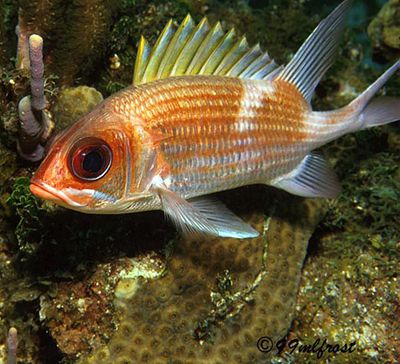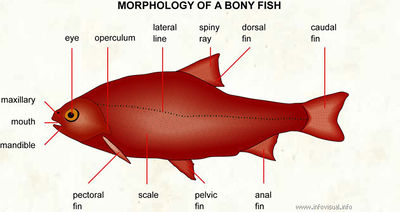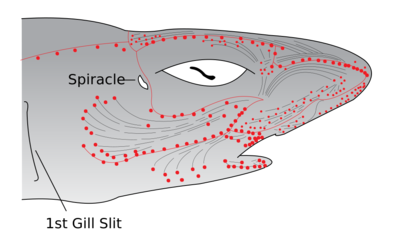Fish senses (Biology)
Contents
Fish senses

Pores with ampullae of Lorenzini in snout of Tiger shark (By Albert kok (Own work) (http://www.gnu.org/copyleft/fdl.html) or CC-BY-SA-3.0-2.5-2.0-1.0 (http://creativecommons.org/licenses/by-sa/3.0), via Wikimedia Commons)
Fish senses include a variety of mechanisms including light, chemicals, vibrations, and electricity. Successful faunal survival in any environment depends upon an organism's ability to acquire information from its environment through its senses. Fish have many of the same senses as humans; they can see, smell, touch, feel, and taste. Furthermore, they have developed some senses that humans lack, such as electroreception.
Photoreception
 Squirrelfish are nocturnal foragers with extremely large eyes. Photo by Mary Lou Frost. Coral Reef Alliance Photoreception, the ability to detect light, is necessary for vision. Fish have a very keen sense of vision, which helps them to find food, shelter, mates, and avoid predators. Fish vision is on par with human vision; many fish can see in color, and some can see in extremely dim light.
Squirrelfish are nocturnal foragers with extremely large eyes. Photo by Mary Lou Frost. Coral Reef Alliance Photoreception, the ability to detect light, is necessary for vision. Fish have a very keen sense of vision, which helps them to find food, shelter, mates, and avoid predators. Fish vision is on par with human vision; many fish can see in color, and some can see in extremely dim light.
Fish eyes are different from human eyes. Their lenses are perfectly spherical, which enables them to see underwater because it has a higher refractive index to help them focus. They focus by moving the lens in and out instead of stretching the lens. They cannot dilate or contract their pupils because the lens bulges through the iris. As the depth at which fish are found increases, the resident fish's eye sizes increase in order to gather the dimmer light. This pattern continues until the bottom of thephotic zone, where eyes are typically smaller, since there is little sunlight. Nocturnal fish, such as Squirrelfishes, tend to have larger eyes then diurnal fish. Some fish have a special eye structure known as theTapetum lucidum, which amplifies the incoming light. It is a layer of guanine crystals which glow at night. Photons of light that pass trhough the retina are bounced back to be detected again. If the photons are still not absorbed, they are reflected back out of the eye.
Chemoreception
 Spotted goatfish use their barbels to detect prey hiding in the sand. Reef Fish Identification, New World Publications © 1994. (Image by Florent Charpin via reefguide.org) Chemoreception, the ability to detectchemicals, is necessary for faunal smell and taste. Chemoreception is very well developed in the fishes, especially the sharks and eels, which species rely upon this to detect their prey (Predation). Fish have two nostrils on each side of their head, and there is no connection between the nostrils and the throat. The olfactory rosette is the organ that detects the chemicals. The size of the rosette is proportional to the fish's ability to detect scents. Some fish (such as sharks, rays, eels, and salmon) can detect chemical levels as low as one part per billion.
Spotted goatfish use their barbels to detect prey hiding in the sand. Reef Fish Identification, New World Publications © 1994. (Image by Florent Charpin via reefguide.org) Chemoreception, the ability to detectchemicals, is necessary for faunal smell and taste. Chemoreception is very well developed in the fishes, especially the sharks and eels, which species rely upon this to detect their prey (Predation). Fish have two nostrils on each side of their head, and there is no connection between the nostrils and the throat. The olfactory rosette is the organ that detects the chemicals. The size of the rosette is proportional to the fish's ability to detect scents. Some fish (such as sharks, rays, eels, and salmon) can detect chemical levels as low as one part per billion.
Fish also have the ability to taste. They have taste buds on their lips, tongue, and over a large portion of their mouths. Some fish, such as the goatfish or catfish, have barbels, which are whiskers that possess taste structures. Goatfish dig through the sand with their barbels looking for invertebrate to eat, and can taste them before the prey even reach their mouths.
Mechanoreception
Mechanoreception, the ability to detect vibrations, is responsible for hearing and touch. Fish have ears, located within their bodies, as well as a lateral line system that actually lets them feel their surroundings.
 The morphology of a bony fish. Diagram from The Visual Dictionary Fish do not have external ears, but sound and vibration readily transmit from the water through the fish's body to its internal ears. The ears are divided into two sections, an upper section (pars superior) and a lower section (utriculus) The pars superior is divided into three semicircular canals, which provide the fish with a sense of balance; this organ is fluid-filled and contains with sensory hairs. The sensory hairs detect the rotational acceleration of the fluid. The canals are arranged so that one gives yaw, another pitch, and the last- roll. The utriculus enables the fish to process incoming sound waves, e.g. permits the sense of hearing. The utriculus structure has two large otoliths, both of which vibrate with the sound and stimulate surrounding hair cells.
The morphology of a bony fish. Diagram from The Visual Dictionary Fish do not have external ears, but sound and vibration readily transmit from the water through the fish's body to its internal ears. The ears are divided into two sections, an upper section (pars superior) and a lower section (utriculus) The pars superior is divided into three semicircular canals, which provide the fish with a sense of balance; this organ is fluid-filled and contains with sensory hairs. The sensory hairs detect the rotational acceleration of the fluid. The canals are arranged so that one gives yaw, another pitch, and the last- roll. The utriculus enables the fish to process incoming sound waves, e.g. permits the sense of hearing. The utriculus structure has two large otoliths, both of which vibrate with the sound and stimulate surrounding hair cells.
Fish possess another sense of mechanoreception that is kind of like a cross between hearing and touch. The organ responsible for this is the neuromast, a cluster of hair cells which have their hairs linked in a glob of jelly known as cupala. All fish posses free neuromasts, which come in contact directly with the water. Most fish have a series of neuromasts not in direct contact with the water. These are arranged linearly and form the lateral lines of the fish anatomy. A free neuromast gives the fish directional guidance input.
A lateral line receives signals stimulated in a sequence, and gives the fish much more information (feeling the other fish around it for polarized schooling, and short-range prey detection 'the sense of distant touch').
Man made underwater noise, such as ship engine emanations, can interfere with fish perception of sound in their natural environment of the underwater. The result is a form of noise pollution manifested in the subsurface of seas, rivers or lakes. Adverse consequences of such underwater noise pollution can occur such as interference with fish to locate prey and to execute navigation.
Electroreception
 Electroreceptors (ampullae of Lorenzini) and lateral line canals in the head of a shark (Diagram from Chris Huh, via Wikimedia Commons) Electroreception, the ability to detect electrical potential, is found in many groups of fishes including lampreys, cartilaginous fishes, some non-teleost ray-finned fishes, and teleost fishes. Electroreception is generally used to assist fish in locating their prey. In some species, electroreceptors are concentrated near the head, whereas others have electrorectors spread across their bodies.
Electroreceptors (ampullae of Lorenzini) and lateral line canals in the head of a shark (Diagram from Chris Huh, via Wikimedia Commons) Electroreception, the ability to detect electrical potential, is found in many groups of fishes including lampreys, cartilaginous fishes, some non-teleost ray-finned fishes, and teleost fishes. Electroreception is generally used to assist fish in locating their prey. In some species, electroreceptors are concentrated near the head, whereas others have electrorectors spread across their bodies.
Sharks and rays possess special organs for detecting electrical potential (voltage). A set of pits comprise the electroreceptive system called theampullae of Lorenzini. These are canals in the skin filled with a gelatin-like material that also contain sensory cells. Movements or disturbances near the shark change the voltage drop along the canals, which allows the shark to sense other organisms nearby. These sensors are so sensitive that if there were not any other distortions a shark could detect the heartbeat of a fish 500 miles away! They can detect muscular contractions of struggling prey and even the earth's magnetic field (which sharks may use for navigation).
References and Further Reading
- Jason Buchheim. A quick course in ichthyology. Marine Biology Learning CenterOdyssey Expeditions
- SeaWorld/Busch Gardens Animal Information Database. 2002. Fish Senses
- University of Cambridge. 2010. Map of Life. Electroreception in fish, amphibians, and monotremes